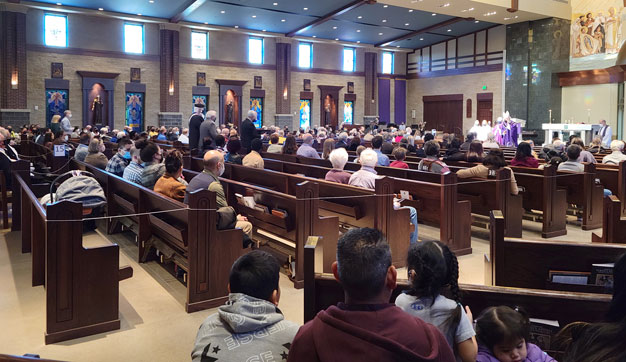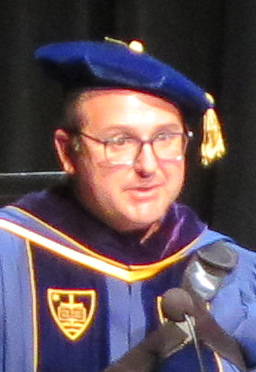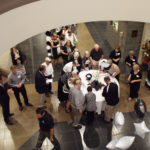
(To read the final report visit https://tinyurl.com/2c6w5kcu)
By Barb Arland-Fye
The Catholic Messenger
Heart-felt comments about the Catholic Church from adults and youths in the Diocese of Davenport have been synthesized in a 10-page diocesan Synod summary (with appendices) and sent to Region IX of the U.S. Conference of Catholic Bishops. The regional group will synthesize the summaries from its members — the dioceses of Iowa, Kansas, Missouri and Nebraska — to include in a national summary. Bishop Thomas Zinkula is leading the regional group. Synthesized summaries from throughout the world will be shared at the Synod of Bishops in 2023.
“Now that we’ve heard from more than 6,000 people about their experience of the Church, we need to discern next steps. This is a gift and we are responsible for stewarding,” said Patrick Schmadeke, diocesan Director of Evangelization. “There is something sacred about listening to people’s experience of the Church. To hear what breaks and fills people’s hearts about the Church is a gift.”
Schmadeke said the Synod “has highlighted how diverse people’s experience of the Church is and it has highlighted the importance of listening in order to understand. In a world of heated debate, we always need to begin by genuinely trying to understand one another. Everyone’s perspective is based on their personal experience and no two people’s experiences are identical. Listening enhances the bonds of community.”
Bishop Zinkula views the Synod process through the “Catholic ‘see-judge-act’ lens. We have spent a considerable amount of time and effort ‘seeing,’ in this case hearing, from people through the synodal process. We also heard a great deal previously in connection with the Vision 20/20 listening sessions and the Rediscovering Sunday surveys.”
“Now it is time to ‘judge,’ to discern. What have we heard? We have already identified some themes — leadership; welcoming/belonging/inclusiveness; Church teaching/tradition; liturgy; community; youth/family engagement; outreach/evangelization; prayer/spirituality; image of the Church; Church rules; polarization/politics.
We need to take some time now to reflect and discuss and plan,” the bishop said. “Eventually, it will be time to act, to develop a strategy for how to address what we have discerned in response to what we have heard.”
Synod insights
Schmadeke said the summary’s appendices (18 pages) “give a fuller picture of how the Synod was lived out in the diocese as well as insights into people’s concrete experience of the Synod. The appendices help ‘tell the story’ of the Synod in our diocese.”
Among the insights are a breakdown of responses that emerged from the synthesis committee’s reading of the nearly 14,000 comments from the listening sessions. The committee categorized comments according to what fills or breaks respondents’ hearts — what the Church is doing well and not so well. Polarization/politics broke hearts for 97% of the commenters while 3% viewed politics from a positive perspective. Church teaching/tradition filled the hearts of 61% of the commenters but 39% had concerns about it. While 74% of the commenters said a sense of community fills their hearts, 26% said lack of community broke their hearts.
Good liturgy filled the hearts of 72% of the commenters but 28% were concerned about the quality of liturgy. Welcoming/sense of belonging/inclusiveness filled hearts for 46% of the commenters while 54% said the Church lacked in that area. The image of the Church filled the hearts of 27% of commenters but 73% expressed concerns about the Church’s image. Outreach/evangelization filled the hearts of 64% of commenters but 36% found outreach/evangelization lacking.
A number of specific topics also emerged from Synod listening sessions. Among the topics: abuse (scandal, cover-up); women (deaconess, ordain women); COVID-19 (masks, vaccines); LGBTQ+ (trans, gay, orientation); social action (justice, Catholic Social Teaching, homeless); divorce (annulment); finances (budget, capital campaign); abortion (pro-choice); priests (shortage, celibacy); left (alienated, left the Church); immigration (migrant, border).
Committee observations
“The report emphasizes just how much we yearn for unity and belonging as a universal Church,” said synthesis committee member Francesca To of Divine Mercy Parish in Burlington/West Burlington. “Our hearts are broken by polarization, by misunderstanding, by actual vs. perceived differences and by what we may rightly or wrongly see as misinterpretations of Catholic teaching. This entire exercise highlights the value of listening — of allowing someone to speak their heart unhampered and of taking their thoughts and feelings seriously — even when we think we know what we are going to hear.”
She noted that “the Synod and this reporting were performed at the request of the Vatican, and some of the issues raised can only be adequately addressed at an institutional level.” However, “the report brings to light many things that can be addressed individually and in our own parishes and local communities. There is a communal desire for change. We hope our Church leaders can pave the way, but there are certainly many opportunities for us individuals to make and be the change we want to see.”
“After reading the report, I can share that I am proud to be part of this diocese as I feel the report reflects the thoughts and experiences of those sitting in the pews,” synthesis committee member Sharon Roling said. “While the ‘heartbreaks’ were difficult to read, I feel it is important that they were named so we can take action to help heal the wounds and mend fragile hearts. The ‘fills your heart’ comments gave life to this report, revealing the hope and joy that exist in our parishes and diocese,” added Roling, principal of St. Joseph Catholic School in DeWitt.
“The appendices indicate how important diocesan leaders viewed Pope Francis’ directive. Innovative, forward thinking, and love of our faith are words that characterize the methods used to gather data for this report,” Roling said. “It is my hope that this report becomes a springboard for action, and not another binder for the diocesan archives. We must celebrate our success, while knowing that our evangelization efforts are just at the beginning stages.”
Synod organizers discovered it was much easier for Catholics to listen to those already in the pews. The Synod summary concludes with this observation: “In its mission of evangelization, the Church must be outward-facing at both institutional and interpersonal levels. Our inward-facing structures must nurture outward-facing habits, and newer outward-facing structures need to be cultivated. The people of God have a great ability to reach out to those who are not already in our pews. The institutional Church must support them in these efforts.”
Portrait of the Church
Synthesis committee member Ken Novak shared a brief reflection on his impressions of the diocesan Synod and one of the themes that emerged from it — “image of the Church.”
 “‘Image’ matters, in my opinion, as it draws the past and the future into the present moment,” explained Novak, the husband of Amy Novak, president of St. Ambrose University in Davenport. “In the synod report, we listen to the voices of the faithful paint a picture of the Church’s image. To some, the lack of women in leadership and the silencing of women’s voices obscures the Church’s image.”
“‘Image’ matters, in my opinion, as it draws the past and the future into the present moment,” explained Novak, the husband of Amy Novak, president of St. Ambrose University in Davenport. “In the synod report, we listen to the voices of the faithful paint a picture of the Church’s image. To some, the lack of women in leadership and the silencing of women’s voices obscures the Church’s image.”
“The image of the Church as the Body of Christ blurs for some when the focus highlights rigid rules rather than inclusive relationship. ‘Can the eye tell the hand that it does not need it?’ (1 Cor. 12:21). On the other hand, the Church’s image enhances, beautifies and clarifies by the continuity of belief, the sanctification of the earthly world by a sacramental vision and the diverse universality of millions who make one profession of faith.”
“We shake our heads at our slowness to change. We wring our hands at the emptying pews or the what-if’s that haunt our dreams of the Church to come. We lift our hearts to the miracle of a Church still standing and the promise that Jesus will never leave us until the end of the age” (Matt 28:20).
“What is this Church for whom our hearts are filled and broken? It is our present engagement with eternity. We don’t pretend our past pain or future worries don’t exist, but we recognize that as people of faith, the present moment challenges us to see beyond a fearful image of the Church, and paint a present reality colored with the best we can bring forth.”
“Image is the fusion of colors from the past and our conjectured shapes of the future, both brought forth with confidence into the present moment. Everybody’s image of everything is different, yet it paints on the same eternal canvas. We have a patient Creator who looks at our finger painting and tells us like a kind, encouraging parent, ‘I can see that,’ and puts our image on the eternal fridge door, until one day when we are ‘older’ we can laugh at our image, our confidence, and the Creator who held our imagination so tenderly.”











